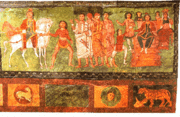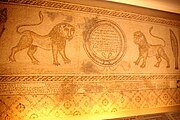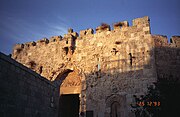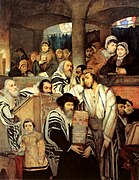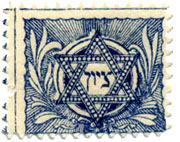Usuario:Calimeronte/taller
Apariencia
Esta es mi zona de pruebas. Es subpágina de mi página de usuario y me sirve para hacer pruebas. Ella no es un artículo de la enciclopedia. Solicito no modificarla. Gracias, Calimeronte
Trabajados
- Arte judío
- Arte asquenazí
- Beth Hatefutsoth
- Cristo en el judaísmo
- Cristo entre los doctores
- Diez Mandamientos
- Estrella de David
- Éxodo
- Golem
- Gottlieb - Maurycy Gottlieb
- Habiru
- Hebreos
- Historia de los judíos
- Insignia amarilla
- La fuente de la gracia
- Liebermann - Max Liebermann
- Lilien - Ephraim Moses Lilien
- Menorá
- Museo de Israel, Jerusalén
- Profeta
- Santa María la Blanca
- Sinagoga Hurva
- Sumo Sacerdote - Anexo:Sumos Sacerdotes de Israe
- Templo de Jerusalén
- Yidis
Trabajados eventualmente
- Abraham
- Arte sefardí
- Biblia de Alba
- Capricho (arte)
- Cautiverio de Babilonia 586-537 aEC
- Crónicas de Núremberg
- Cúpula de la Roca
- Doce Tribus de Israel
- Dybbuk
- Efraím
- Gótico español
- Hartmann Schedel
- Israelita
- Jehú
- José (patriarca)
- Judaísmo y cristianismo
- Macabeos
- Manasés (hijo de José)
- Mevaseret Sion
- Modernismo (arte)
- Obelisco Negro
- Oseas
- Palmaj
- Sinagoga
- Tabernáculo
- Tierra Prometida
- Tribu de Efraín
- Tribu de Leví
- Tribu de Manasés
- Pogromo de Kishinev
- Sanctasanctórum (débir)
Aún sin trabajar
- Agam - Yaacob Agam
- Arca de la Alianza
- Biblia hebrea
- Chagall - Marc Chagall
- Diáspora sefardí
- Diez Mandamientos
- Divisiones étnicas judías
- Dura Europos
- Estela de Mesha (inscripciones paleohebreas), siglo IX aEC
- Gueto
- Hagadá
- Hebreo - Idioma hebreo
- Hilel
- Historia de los judíos
- Historia de los judíos en España
- Historia de los judíos en la Tierra de Israel
- Historia del Antiguo Israel
- Reino de Israel
- Monarquía Unida — United Kingdom of Israel and Judah, 1020-930 aEC
- Reino del norte (Samaria) — Kingdom of Israel (Samaria), 930-720 aEC
- Reino de Judá — 930-587 aEC
- Holocausto
- Homaranismo - Hilelismo
- Israëls - Jozef Israëls
- Mendelsohn - Erich Mendelsohn
- Museo de Arte y de Historia del Judaísmo, París
- Oppenheim - Moritz Daniel Oppenheim
- Pueblo judío
- Sion
- Solución final
- Sucot
- Talmud
- Tanaj
- Teoría del reemplazo
- Tierra Santa
- Tribus de Israel
- Zona de Asentamiento
A ser creados
- Bak - Samuel Bak
- Judaica
- Raban - Ze'ev Raban
- Sumo Sacerdote de Israel - existe sólo como Anexo:Sumos Sacerdotes de Israel
- Szyk - Arthur Szyk — Rubáiyát of Omar Khayyám 1940 (poesía persa siglos XI-XII) ; Batalla del Gueto de Varsovia 1945 ; Historia Visual de las Naciones: IL 1945-49 ; Hagadá 1956 ; sitio oficial.
- Roca Fundacional o Roca de la Fundación
Compilación material a ser incluido en entradas diversas

-
La así llamada "Roca Fundacional" (hebreo: אבן השתייה, Even Hashetiá; árabe: صخرة, Sajrah) preservada en el interior del Domo de la Roca
-
Moisés con los Diez Mandamientos
-
Las Doce Tribus de Israel, 1200-1050 a.EC.
-
La monarquía dividida: Reino de Judá (sur) y Reino de Israel (norte), 926 a.E.C. (Bible Society, 1888).
-
Reino de Judá y Reino de Israel, c. 830 a.E.C.
-
Exilio babilónico. Deportación de los judíos del Reino de Judá a Babilonia tras la destrucción del Templo de Salomón (Tissot, 1896-1902)
-
Reino de Herodes el Grande, siglo I
-
Segundo Templo de Jerusalén
-
Fragmentos arqueológicos judaico y romano. Fotografiados por Auguste Salzmann en 1853.
-
Sitio y destrucción de Jerusalén por los romanos, 70 EC (Roberts, 1850)
-
Espolios de Jerusalén, 70 EC
-
Dura Europus, 244 EC
-
Moisés, Dura Europus, 244-256
-
Mosaico del Sinagoga de Beit Alfa, siglo V
-
Mosaico en la Sinagoga de Seforis, siglo V
-
Mosaic proveniente de la Sinagoga de Hamat Gader, siglo V-VI
-
Mosaico con Menorá, lulav y etróg, siglo VI.
-
Llegada de los judíos a Polonia, 1096 (Jan Matejko, s. XIX).
-
Los cruzados capturan Jerusalén, 1099
-
Hagadá Barcelona, s. XIV, fol. 42v
-
Hagadá Cataluña, s. XIV. Versificación: "Ilu... ve lo..."
-
Puerta de Sion, Jerusalén, 1540
-
Beit Hamikdash. Insignia hebrea con bendiciones de Marco Antonio Giustiniani, que incorpora una imagen del Templo de Jerusalén representado a partir del Domo de la Roca como fuente de inspiración al Domo de la Roca; Venecia, 1546
-
Judíos asquenazíes rezando en una sinagoga, s. XIX (Gottlieb)
-
Emancipación de los judíos, 1806
-
Liebermann, Jesús en el Templo, 1879
-
Degradación de Alfred Dreyfus (Le Petit Journal, 1895).
-
Musée des Horreurs: Le Traître, litografía, 1899
-
Sion, 1901-2
-
La calle Hester, Nueva York, 1903
-
Emigrantes, c. 1920
-
Auschwitz: "El trabajo libera".
-
Europa: Holocausto
-
Ivangorod, 1942
-
Buchewald, 1945
-
Mandato Británico de Palestina, 1920
-
Guardia de un kibbutz, 1936
-
Plan de la ONU para la división de Palestina, 1947
-
Puerta de Sion, después de la Guerra árabe-israelí de 1948
-
Arthur Szyk, Estampilla, 1950.
-
Idem
-
Israel y los territorios en litigio, 2005
Recursos a ser incorporados
Material a traducir y explorar su imaginería:
- Washington, D.C., Library of Congress, Arthur Szyk: Artist for Freedom, diciembre de 1999-mayo de 2000; accedido 22 de junio de 2014. Arthur Szyk (1894 - 1951) was one America's leading political artists during World War II, when he produced hundreds of anti-Axis illustrations and cartoons in aid of the Allied war effort. Throughout his career he created art in the service of human rights and civil liberties -- in his native Poland, in Paris where he was trained during the 1920s, and in America, the country he adopted in 1940. Settling in the United States, Szyk announced, "At last, I have found the home I have always searched for. Here I can speak of what my soul feels. There is no other place on earth that gives one the freedom, liberty and justice that America does." / Born of Jewish parents in Lodz, Poland, Szyk acquired his early art training in Paris and Cracow. Between 1919 and 1920, during Poland's war against the Soviet Bolsheviks, he served as artistic director of the Department of Propaganda for the Polish army regiment quartered in Lodz. In 1921, he moved to Paris where he lived and worked for ten years. In 1934, Szyk traveled to the United States for exhibitions of his work, including one at the Library of Congress where a series of thirty-eight miniatures commemorating George Washington and the Revolutionary period were shown. In late 1940, after a period of residence in England, he immigrated to the United States. / In America, Arthur Szyk embraced the patriotic and democratic spirit of his adopted country. His work entitled The United States of America, includes portrayals of an African American and Native American, representing the diversity of American society, as well as familiar imagery -- Hoover Dam, the Manhattan skyline, the Golden Gate Bridge, and the Pony Express. His anti-Axis cartoons appeared frequently in such popular magazines as Collier's and in two published compilations, The New Order (1941) and Ink & Blood (1946). He also illustrated numerous works, including a richly rendered, magnificently printed Haggadah (1940), reflecting his passion for his own Jewish heritage and concern for the Jewish people in the face of Nazi hostility.
- Washington, D.C., Library of Congress, Scrolls from the Dead Sea: The Ancient Library of Qumram and Modern Scholarship, abril-agosto de 1993; accedido 22 de junio de 2014. The exhibition Scrolls From the Dead Sea: The Ancient Library of Qumran and Modern Scholarship brings before the American people a selection from the scrolls which have been the subject of intense public interest. Over the years questions have been raised about the scrolls' authenticity, about the people who hid them away during the period in which they lived, about the secrets the scrolls might reveal, and about the intentions of the scrolls' custodians in restricting access. The Library's exhibition describes the historical context of the scrolls and the Qumran community from whence they may have originated; it also relates the story of their discovery 2,000 years later. In addition, the exhibition encourages a better understanding of the challenges and complexities connected with scroll research.
- Washington, D.C., Library of Congress, Words Like Sapphires: 100 Years of Hebraica at the Library of Congress, 1912–2012, octubre de 2012-abril de 2013; accedido 22 de junio de 2014. The Hebraic Section of the Library of Congress is recognized as one of the world’s foremost centers for the study of Hebrew and Yiddish materials. Its beginnings can be traced to Jacob H. Schiff’s gift in 1912 of nearly 10,000 books and pamphlets. In the century since Schiff’s initial gift, the Library has expanded its Hebraic holdings to close to 200,000 works in Hebrew and related languages.
Ilustraciones temas varios
Arca de la Alianza Augusta Victoria
-
Tabernáculo
-
Holman, The Tabernacle, 1890
-
Holman, The Tabernacle in the Wilderness, 1890
-
Réplica del Arca de la Alianza
-
The Erection of the Tabernacle and the Sacred vessels (right plate); as in Exodus 40:17-19: "And it came to pass in the first month in the second year, on the first day of the month, that the tabernacle was reared up. And Moses reared up the tabernacle, and fastened his sockets, and set up the boards thereof, and put in the bars thereof, and reared up his pillars. And he spread abroad the tent over the tabernacle, and put the covering of the tent above upon it; as the Lord commanded Moses."; illustration from the 1728 Figures de la Bible; illustrated by Gerard Hoet (1648–1733) and others, and published by P. de Hondt in The Hague; University of Oklahoma Libraries
-
Transport of the Ark, Auch Cathedral, France
-
Tissot, The Ark Passes Over the Jordan, between 1896 and 1902
-
Les Très Riches Heures du duc de Berry, Folio 29r - The Ark of God Carried into the Temple, 1412-15. Musée Condé, Chantilly
-
Replica of the Ark of the Covenant in the Royal Arch Room of the George Washington Masonic National Memorial
-
Parochet for Yamim Noraim in Mizmor L'Assaf Shul, made by Efod Art Embroidery, Nahariya, 2011
-
Isidor Kaufmann, Day of Atonement, 1907
-
Jakub Weiles, On the eve of Yom Kippur, c. 1890. National Museum, Varsovia
-
Cherubim, from ulius Bate, A new and literal translation, from the Hebrew, of the Pentateuch of Moses, and of the historical books of the Old Testament, to the end of the second book of Kings (1773).
-
Ark of the Covenant church in Axum, Ethiopia, 2004
-
Choeur de l'église du monastère de l'Annonciade à Menton. Avec une réplique de l'Arche d'Alliance
-
Tissot, The Seven Trumpets of Jericho 1896 and 1902
-
High priest in robes and breastplate
-
Tissot, A Patriarch, 1850
-
Cementerio Judío, Heinheim, Alemania, siglo XVII
-
Idem
-
Judaismo y Cristianismo. Biblia: frontispicio con tribus y apóstoles. Sur la colonne de gauche les médaillons des 12 tribus d'Israël (1. RUBEN 2. SIMON (épée) 3. LEVI 4. JUDAH (lion) 5. DAN 6. NEPHTALI 7. GAD 8. ASHER 9. ISSACHAR 10. ZEBULON 11. JOSEPH 12. BENJAMIN ) et sur la colonne de droite ceux des 12 apôtres. One of 6,330 prints in the 45 volumes of the Bowyer Bible in Bolton Museum, England.
-
Ze'ev Raban
-
Tribus, vitral. Sinagoga de Shilo.
-
Judá y el león; escenas de la historia de Ester. Moscú, 1690
-
Cementerio judío de Skwierzyna, Polonia
-
Cementerio judío de Radom
-
Cementerio judío de Będzin
-
Cementerio judío de Thiais
Symbols on Jewish gravestones
- Star of David : The six-pointed Star of David, a symbol of Judaism, is frequently found on Jewish tombstones.
- Cohanim Hands – Priestly Blessing : Two hands with outspread fingers indicated that the dead man was descended from priestly stock (Kohanim) who blessed the people in this fashion
- Ewer : Levite pitcher (and bowl)
- the shofar (ram's horn) indicating that the deceased was a blower of the shofar
- deer : people whose name is Zvi, Hirsch or Naftali (deer representing the tribe of Naphtali)
- lion : people whose name is Aryeh, Judah, Leib or Loew (lion representing the tribe of judah)
- bear : people whose name is Dov and Ber.
- wolf : representing the Tribe of Benjamin
- books : an open book indicates the presence of a rabbi, an officiating minister, or just a scholar
- bookshelves : groups of books, sometimes arranged in an open bookcase, or on shelves.
- fish : zodiac sign for the month of Adar
- menorah : one of the oldest symbols of Judaism
- candles : one of the most accepted symbols of the woman. The candle was lit by the Jewish woman. Most of the candlesticks have three branches but there are ones with two, five and more. A broken candle on a gravestone symbolizes an early death, at a young age.
- crown . כתר שם טוב "crown of a good name" (based on Mishna in Avos 4:17)
- tree : A broken tree or branch is a sign that the deceased was young at the time of death
- bird : appears on the gravestones of many women
- grapes : cluster of grapes is an emblem of Israel,
Biblia por Tissot
-
Dios renueva sus promesas con Abraham
-
Moisés
-
Cantos de alegría
-
Moisés con el Decálogo
-
Bezalel
-
Moisés y Josué en el Tabernáculo
-
Isaías
-
Zacarías
-
Jonás
Referencia bíblica
- Biblia Paralela
- BibleGateway
- Mercer Dictionary of the Bible, ed. Watson E. Mills y Roger Aubrey Bullard, Mercer UP, 1990
Filatelia
-
"Noah's dove from Jerash". Inscription on tab: "Mosaic floor of the synagogue at Jerash".
-
"The Marise Eagle". Inscription on tab: "Eagle carved on one of the tombstones found at Marisa".
-
"The Bet Shearim Eagle". Inscription on tab: "Eagle carved in stone al Bet Shearim".
-
"Ostrich Bet Alpha". Inscription on tab: "Mosaic floor of the synagogue at Bet Alpha"
-
"Doves on ancient pottery lamps". Inscription on tab: "Pair of doves as Decoration on pottery lamps".
-
Zodíaco - "He creado 12 constelaciones sobre el firmamento" (Brajot 32b; I. Blaushild)
-
Levítico 19:18
-
"...the land... it floweth with milk and honey..." Numbers XIV, 8
-
Saúl (A. Kalderon, 1960)
-
David (A. Kalderon, 1960)
-
Salomón (A. Kalderon, 1960)
-
"Flying Scroll - To the King - seal stamped on the wine and oil jugs given as tax to the king".
-
Sansón (A. Kalderon, 1961)
-
Isaías 11:6
-
Isaías 11:6
-
Isaías 11:8
-
Holy Ark in a synagogue in Safed. "...Joy and gladness, and cheerful feasts" Zechariah VIII, 19
-
Holy Ark in a synagogue in Jerusalem. "...Joy and gladness, and cheerful feasts" Zechariah VIII, 19
-
Holy Ark in a synagogue in Petah Tikva. "...Joy and gladness, and cheerful feasts" Zechariah VIII, 19
-
Judá Macabeo (A. Kalderon, 1961)
-
Bar Kojba (A. Kalderon, 1961)
-
Floor mosaic of the ancient Bet Alpha synagogue showing an allegorical illustration of the sun surrounded by the twelve signs of the Zodiac
-
Maimónides
-
Procesión solemne de los judíos de Praga, grabado, 1741
-
Procesión solemne de los judíos de Praga, grabado, 1741
-
Eliezer Ben-Yehuda
-
Hayyim Nahman Bialik
-
Shalom Aleijem
-
Antigua Academia Bezalel, Rejavia, 1907. Gabriel y Maxim Shamir, 1957
-
Library building of the Hebrew University in Jerusalem on Mount Scopus
-
7 especies - shivat ha'minim. Inscr. "A land of wheat, and barley, and vines, and fig trees, and pomegranates; a land of oil olive, and honey" Deuteronomy VIII, 8 (Zvi Narkiss, 1958)
-
Trigo
-
barley
-
Vid
-
Higo
-
Granada
-
Oliva
-
Miel
-
Menorá y tribus. "...And the children of Israel shall pitch their tants, every man by his own camp and every man by his own standard..." Numbers I: 52. - Otte Wallish, 1952
-
Menorá (G. Hamori, 1955)
-
Memorial Day for the Fighters for Independence 1958 - Otte Wallish
-
Torá - Wind-Struski, 1951
-
Sion - "...the land shall not be sold for ever..." Leviticus XXV, 23 - Wind-Struski, 1951
-
Janusz Korczak
Ayuda
- Tablón de bibliotecarios
- Jkbw (berlín)
- Aviador (reversor)
- Lourdes (supresora)
Destructividad dolosa y persistente
- Asunto
- Vandalismo insistente y doloso de REGISTRO , [https: ... aquí], FECHA. - Solicito su exclusión de Wikipedia por destructividad intencional y persistente. Justificación: al focalizar en la investigación y desarrollo de cada artículo invertimos tiempo y dedicación en nuestro quehacer; ese ha debe ser nuestro trabajo y no perder el tiempo con gente que se dedica a destruir Wikipedia - Para sentar precedente, en caso de no haberlo, o bien para reafirmar nuestras políticas, la respuesta de los bibliotecarios wikipedísticos debe ser inequívoca, severa y contundente, caso contrario perderemos nuestras vidas SOLO revirtiendo los caprichos de anónimos malintencionados. No estaría por otra parte de más el que sólo los usuarios registrados podamos editar: por el momento libramos una batalla contra "fantasmas". Agradezco y envío mis saludos cordiales para todo el Equipo Wikipedístico,
- Usuario que lo solicita
- --FECHA (UTC) Cali Mero (intracorrespondencia)
- Respuesta
(a rellenar por un bibliotecario)












